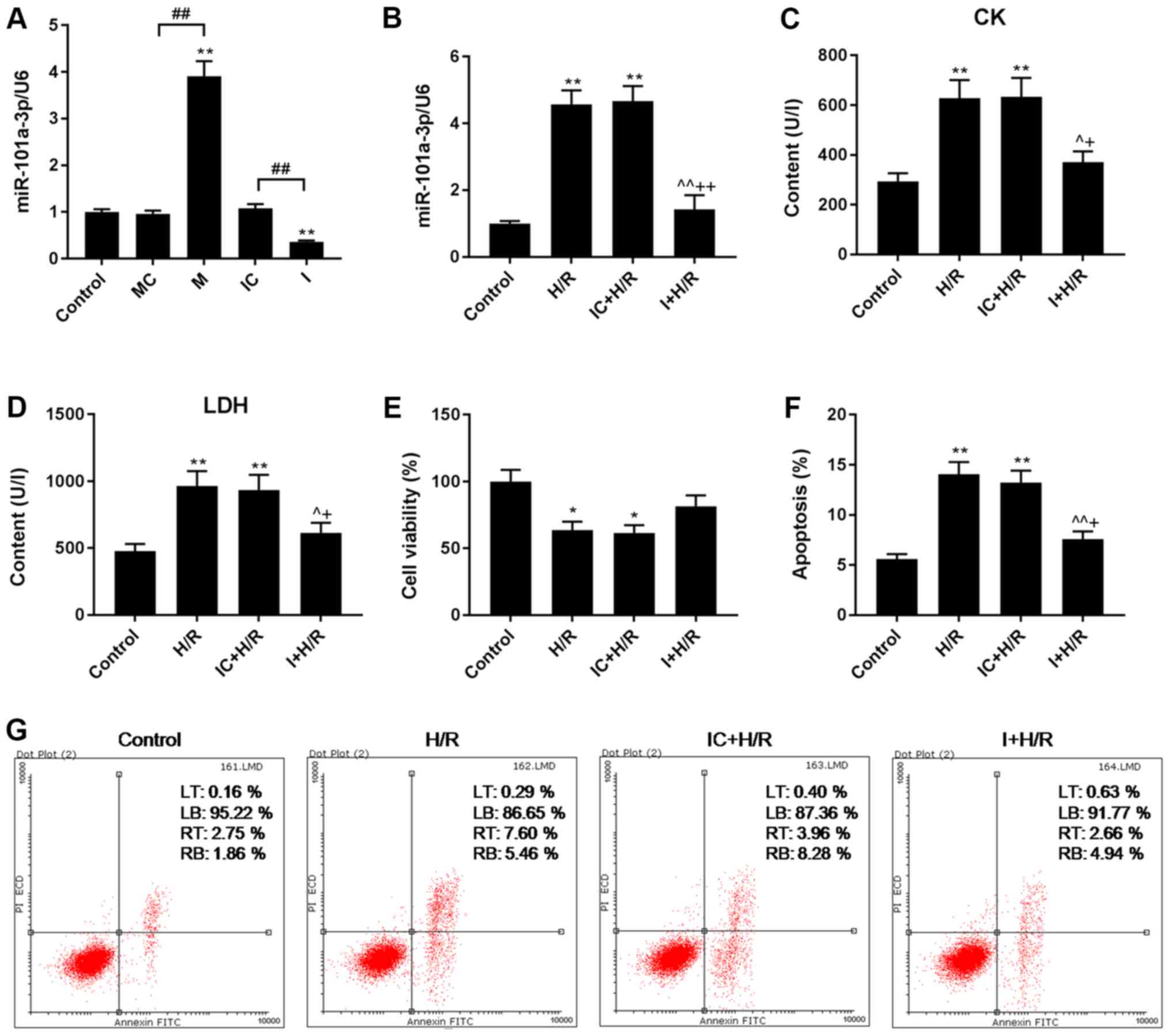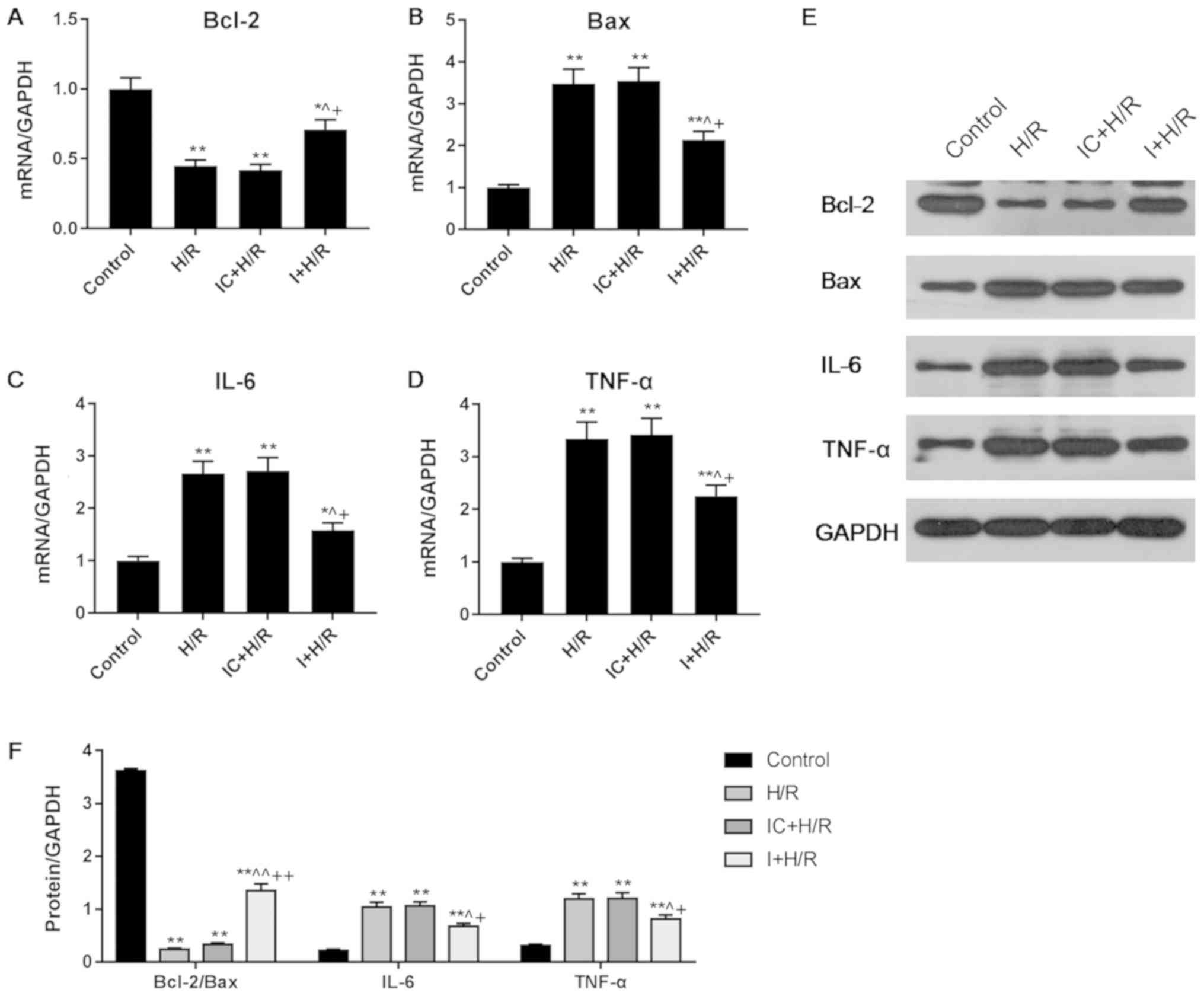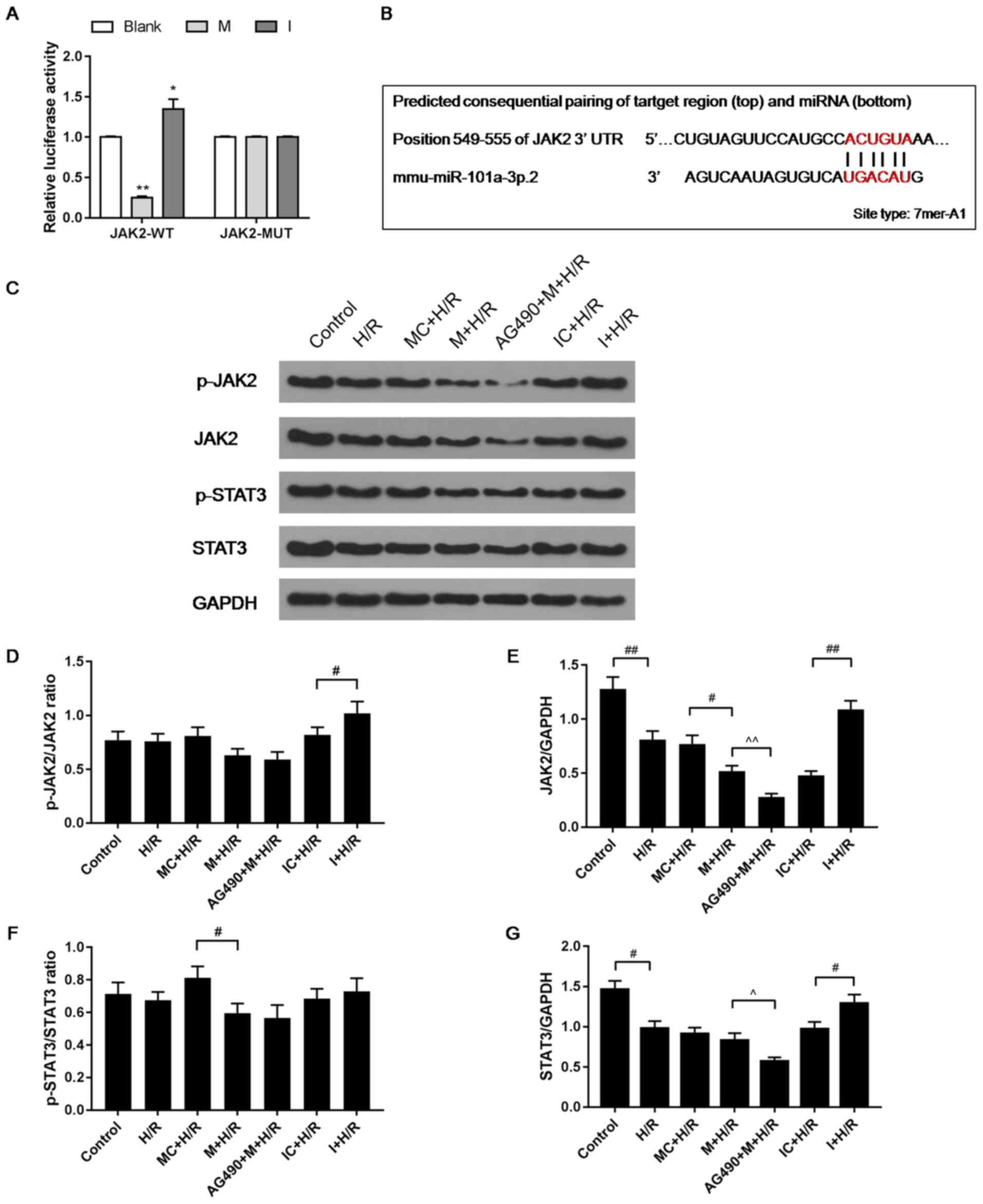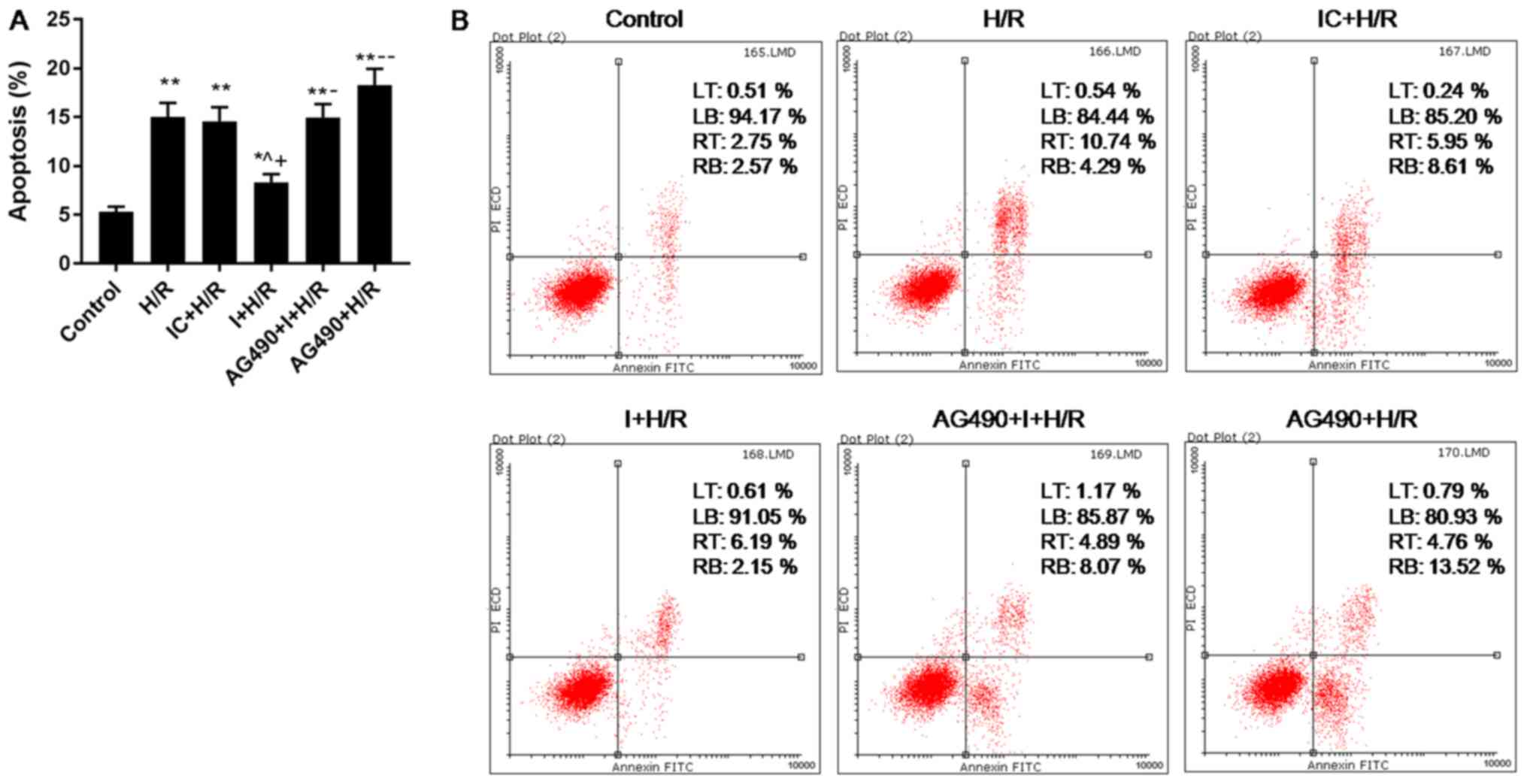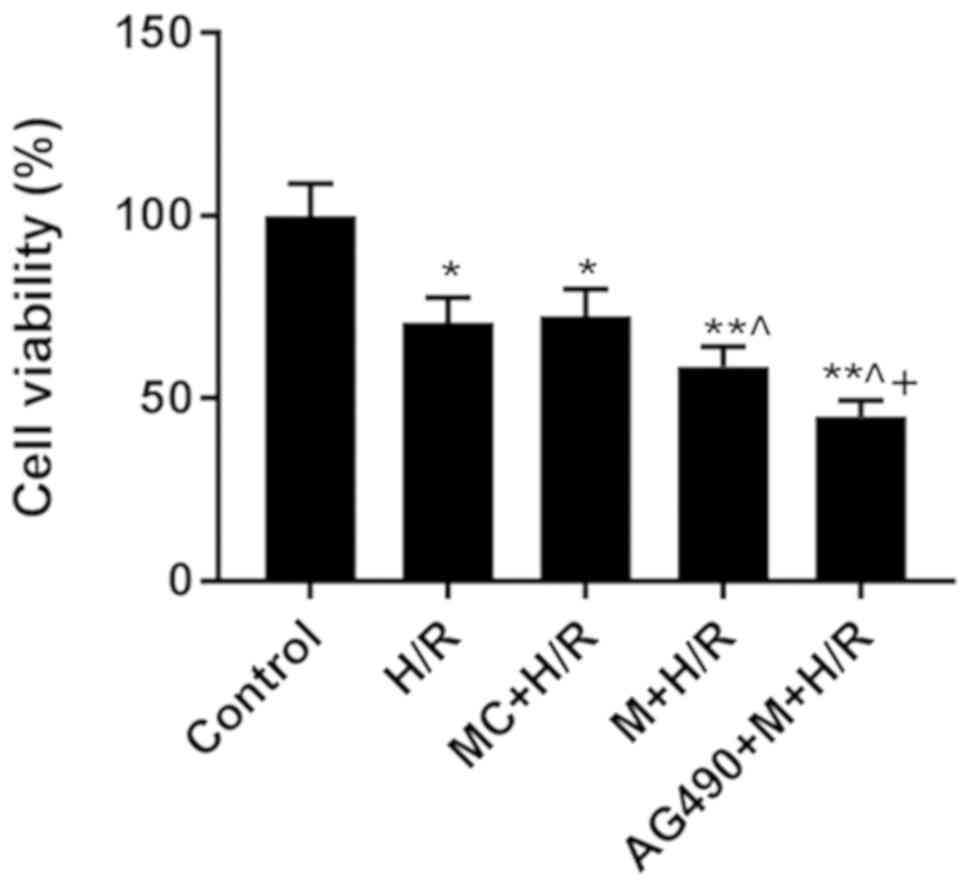The inhibition of miR‑101a‑3p alleviates H/R injury in H9C2 cells by regulating the JAK2/STAT3 pathway
- Authors:
- Published online on: November 5, 2019 https://doi.org/10.3892/mmr.2019.10793
- Pages: 89-96
-
Copyright: © Liu et al. This is an open access article distributed under the terms of Creative Commons Attribution License.
Abstract
Introduction
In vivo, ischemia/reperfusion (I/R) injury refers to organ damage produced by the restoration of blood flow after ischemia. Myocardial I/R injury is a common phenomenon that occurs after ischemic heart diseases such as myocardial infarction (MI), or is the result of a reduction in blood flow and oxygen supply insufficiency (1). MI is a cause of morbidity in cardiovascular diseases (2,3). Limiting or reducing the damage following I/R has received extensive research attention. In vitro, an hypoxia/reoxygenation (H/R) injury model simulates in vivo I/R injury (2).
Overexpression of microRNA-101 (miR-101) has been found in cell inflammation injury, and downregulated expression of miR-101 can attenuate cell injury (4,5). miR-101a is upregulated during cell differentiation, and overexpressed miR-101 can inhibit cell proliferation and migration, and promote cell apoptosis (6–8). Thus, it was hypothesized that inhibiting miR-101a-3p could attenuate H/R-induced damage in H9C2 cells.
The differentiation, proliferation and migration of cells is critical in the early stages of cell healing, and apoptosis affects the elimination of inflammatory factors during cell healing (9). A number of studies have investigated cell apoptosis via the Bax/Bcl-2 signaling pathway (10–12). In addition, elevated interleukin-6 (IL-6) levels may cause tissue damage and inflammation (13). Studies have demonstrated that tumor necrosis factor-α (TNF-α) is connected with inflammation and injury (14–17). STAT3, a member of the STAT family of transcription factor, regulates cell proliferation, cellular transformation, metastasis and immune responses, whereas Janus kinase (JAK)2 participates in the immune system and other signaling transductions (18,19). Previous studies have demonstrated that inactivation of the JAK/STAT3 signaling pathway relieved cell injury, suggesting that activation of the JAK/STAT3 signaling pathway was correlated with cell injury (20,21).
In the present study, H9C2 cells (rat myocardial cells) were subjected to H/R treatment and established as an I/R injury model in vitro. The aim of the study was to investigate the effect and mechanism of the inhibition of miR-101a-3p on H/R injury. Cell apoptosis in cardiomyocytes, and critical regulation of target factors by inhibition of miR-101a-3p and H/R injury were also studied.
Materials and methods
Cell culture and H/R models
The rat embryonic cardiomyoblast cell line H9C2 was purchased from the American Type Culture Collection. H9C2 cells were cultured in DMEM (Thermo Fisher Scientific, Inc.) at 37°C in an incubator (Thermo Fisher Scientific, Inc.) with 5% CO2. DMEM contained high-glucose basic DMEM (Invitrogen; Thermo Fisher Scientific, Inc.), 10% fetal bovine serum (FBS; Gibco; Thermo Fisher Scientific, Inc.) and 1% 10,000 U/ml penicilin-10,000 µg/ml streptomycin (Gibco; Thermo Fisher Scientific, Inc.). Subculture was conducted when the cells reached ~90% confluence in the culture flask.
To induce H/R models, the cells were cultured in non-glucose basic DMEM (Invitrogen; Thermo Fisher Scientific, Inc.) containing 1% 10,000 U/ml penicilin-10,000 µg/ml streptomycin at 37°C for 24 h under hypoxic conditions (1% O2/95% N2). Then the cells were placed in a normal chamber (at 37°C in 5% CO2/95% air) for 6 h and divided into 6 groups: Control group (untreated); H/R group [cells were exposed to hypoxia/reoxygenation (24/6 h) environment]; miR-101a-3p inhibitor (I) + H/R (cells were transfected with I for 48 h followed by exposure to H/R); miR-101a-3p inhibitor control (IC) + H/R (cells were transfected with IC for 48 h followed by exposure to H/R); Tyrphostin AG490 (AG490; Selleck Chemicals) + H/R (cells were pretreated with AG490 for 30 min followed by exposure to H/R); AG490 + I + H/R (cells were pretreated with AG490 for 30 min, transfected with I for 48 h followed by exposure to H/R). miR-101a-3p mimic (M), miR-101a-3p mimic control (MC), I and IC were purchased from Shanghai GenePharma Co., Ltd.
Cell transfection
H9C2 cells were plated in 35-mm culture dish at 1.5×105 cells/dish for 12 h. The cells were transfected with I, IC, M, MC (50 nM; Shanghai GenePharma Co., Ltd.) using riboFECT™ CP Reagent and buffer (Guangzhou RiboBio Co., Ltd.). RiboFECT™ CP-I/IC mixture and DMEM were added to the cells at 37°C and incubated for 48 h. Reverse transcription-quantitative PCR was applied to detect the transfection efficiency of cells. The sequences of I, IC, M, MC were as follows: M (sense, 5′-UACAGUACUGUGAUAACUGAA-3′ and antisense, 5′-CAGUUAUCACAGUACUGUAUU-3′), MC (sense, 5′-UUCUCCGAACGUGUCACGUTT-3′ and antisense, 5′-ACGUGACACGUUCGGAGAATT-3′), I (5′-UUCAGUUAUCACAGUACUGUA-3′) and IC (5′-AUCGUUCGAUCACGUATT-3′).
Dual luciferase assay
Target genes of miR-101a-3p were predicted using TargetScan7.2 (http://www.targetscan.org/vert_72/). For the dual luciferase reporter experiments, the mutation type 3′-untranslated region (3′-UTR) of JAK2 gene was created by the Quick-Change Site-Directed Mutagenesis kit (Stratagene; Agilent Technologies, Inc.). The JAK2 wild-type 3′-UTR or mutate type (MUT) JAK2 3′-UTR were cloned into psi-CHECK-2 (Promega Corporation) and used to transfect the cells, M and I were co-transfection with JAK2 3′-UTR or JAK2 3′-UTR mutant plasmids (400 ng) into H9C2 cells using Lipofectamine™ 2000 (Invitrogen; Thermo Fisher Scientific, Inc.) for 48 h. Luciferase activity was measured with the Dual Luciferase Reporter Assay system (Promega Corporation) according to the manufacturer's protocols. Renilla luciferase activity served as an internal control.
Cell Counting Kit-8 (CCK-8) assay
Cell viability was detected by CCK-8 (MedChemExpress, LLC). The cells were plated in 96-well plates at 1.5×103 cells/well for 24 h. Following transfection and H/R treatment, CCK-8 solution was added into 96-well plates and diluted in phosphate buffered saline (Gibco; Thermo Fisher Scientific, Inc.) at 9:1, and then incubated in a 37°C, 5% CO2 atmosphere for 1 h. Then, the OD value at a wavelength of 450 nm was measured by Multiskan™ FC (Thermo Fisher Scientific, Inc.).
Colorimetric assays
The supernatants (centrifugation at 10,000 × g for 30 min at 4°C) from the control group, H/R group, IC + H/R group and I + H/R group were collected into centrifuge tubes. Creatine kinase (CK) was detected using a CK test kit (cat. no. BC1140; Beijing Solarbio Science & Technology Co., Ltd.) and lactate dehydrogenase (LDH) was analyzed using an LDH test kit (cat. no. TE0159; Beijing Leagene Biotech Co. Ltd.), according to the manufacturers' protocols.
Reverse transcription-quantitative (RT-q)PCR
RNA was extracted from H9C2 cells (2×104 cells/well in 6-well plates) using TRIzol regent (Invitrogen; Thermo Fisher Scientific, Inc.). An iScript™ cDNA Synthesis kit (Bio-Rad Laboratories, Inc.) was used to synthesize cDNA. The reverse transcription reaction was performed at 42°C for 15 min, followed by reverse transcriptase inactivation at 85°C for 15 sec. RT-qPCR analysis was performed on an ABI Step One Plus sequence detection system (Thermo Fisher Scientific, Inc.) using the conditions and primer concentrations suggested by the SYBR-Green PCR master mix (Thermo Fisher Scientific, Inc.) protocol. Sequence primers used in for qPCR were as follows: miR-101a-3p (forward, 5′-TACAGTACTGTGATAACTGA-3′ and reverse, 5′-GTGCAGGGTCCGAGGT-3′); Bcl-2 mRNA (forward, 5′-GGTGCCACCTGTGGTCCACCTG-3′ and reverse, 5′-CTTCACTTGTGGCCCAGATAGG-3′); Bax mRNA (forward, 5′-AAATACCCGGAGCTGATGTTTG-3′ and reverse, 5′-TCCTCTGGCTGAGTTTGCG-3′); IL-6 mRNA (forward, 5′-CCTGAAC-CTTCCAAAGATGG-3′ and reverse, 5′-CATTTGCC-GAAGAGCCCTCA-3) and TNF-α mRNA (forward, 5′-TGAVAAGCCTGTAGCCCACG-3′ and reverse, 5′-TTGTCTTTGAGATCCATGCC-3′). qPCR reactions were performed under the following conditions: 50°C for 35 min, 85°C for 12 min, followed by 60 cycles of 95°C for 23 sec and 60°C for 1.5 min. GAPDH (forward, 5′-TCCCTCAAGATTGTCAGCAA-3′ and reverse, 5′-CCAGAGGCATACAGGGACAAC-3′) and U6 (forward, 5′-CTCGCTTCGGCAGCACA-3′ and reverse, 5′-AACGCTTCACGAATTTGCGT-3′) were used as internal controls. The 2−ΔΔCq method (22) was used to calculate relative expression levels.
Flow cytometry
Cell apoptosis was determined via flow cytometry. The cells were suspended in PBS after having been treated for 48 h. Then, 1 µl Annexin V/FITC 5X, 150 µl annexin-binding buffer and 2.5 µl propidium iodide (PI) in a Dead Cell Apoptosis kit (Thermo Fisher Scientific, Inc.) were added to 300 µl cell suspension for conducting flow cytometry at room temperature for 15–20 min in the dark. The fluorescence was detected by a flow cytometer (BD Biosciences) and the cell apoptosis was calculated using BD FACSuite software (version 1.0; BD Biosciences). Apoptosis was calculated as the sum of early apoptosis and late apoptosis.
Western blot analysis
Following treatment for 48 h, the cells were washed with PBS 3 times. RIPA buffer (Thermo Fisher Scientific, Inc.) was added to the dish, and the cell were then scraped for 5–6 min using a cell scraper on ice. The liquid was mixed by syringe 3 times and transferred onto the ice and held for 15 min. Next, the liquid was cleared by centrifugation (Cence Medikal) at 12,000 × g for 15 min at 4°C. A bicinchoninic acid protein assay kit (Pierce; Thermo Fisher Scientific, Inc.) was used to determine protein concentration. An equal quantity of total protein (30 µg) was separated via 10% SDS-PAGE and then transferred onto polyvinylidene fluoride membranes (PVDF; Thermo Fisher Scientific, Inc.). After blocking of non-specific binding sites with 5% non-fat milk at room temperature for 2 h, the membranes were incubated overnight at 4°C with antibodies specific for Bcl-2 (cat. no. ab196495; 1:1,000; Abcam), Bax (cat. no. 2772; 1:1,000; Cell Signaling Technology, Inc.), IL-6 (cat. no. 12153; 1:1,000; Cell Signaling Technology, Inc.), phosphorylated (p)-STAT3 (cat. no. 9145; 1:2,000; Cell Signaling Technology, Inc.), STAT3 (cat. no. 12640; 1:1,000; Cell Signaling Technology, Inc.), JAK2 (cat. no. 3230; 1:1,000; Cell Signaling Technology, Inc.), p-JAK2 (cat. no. 3776; 1:1,000; Cell Signaling Technology, Inc.), TNF-α (cat. no. ab6671; Abcam) and GAPDH (cat. no. ab9485; 1:1000; Abcam). Next, the membranes were washed 2–3 times with TBS + 0.05% Tween-20 (TBST) at room temperature and incubated with the horseradish peroxidase-conjugated goat anti-rabbit secondary antibody (cat. no. ab6721; 1:2,000; Abcam) for 2–3 h. After the membranes had been washed with TBST, the proteins were detected using ECL reagent (Beijing Solarbio Science & Technology Co., Ltd.), and the protein blots were analyzed using IPP 6.0 software (Media Cybernetics, Inc.).
Statistical analysis
Data were shown as the mean ± standard deviation. All statistical analyses were performed using SPSS software (version 15.0; SPSS, Inc.). Comparisons of cell viability, apoptosis, CK/LDH and western blot were analyzed using one way ANOVA and Tukey-Kramer multiple comparison tests. P<0.05 was considered to indicate a statistically significant difference. All experiments were performed ≥3 times.
Results
Effects of miR-101a-3p on the H/R-induced H9C2 cell injury
M significantly increased miR-101a-3p expression, and I inhibited miR-101a-3p expression in H9C2 cells (Fig. 1A). Although the expression of miR-101a-3p was higher in H9C2 cells that had been subjected to H/R injury, its expression was inhibited by I (Fig. 1B).
Effects of I on viability, and the contents of CK and LDH in H/R model H9C2 cells
CK has been reported to be linked to diastolic dysfunction in rats (23), and cardiomyocyte damage can be assessed by detecting the content of LDH (24). The expression levels of CK and LDH increased when the cells were subjected to H/R injury, and such expression was decreased by I transfection during H/R (Fig. 1C and D). The data also demonstrated that H/R decreased H9C2 cell viability, whereas I improved cell viability following H/R (Fig. 1E).
Effects of I on H/R-induced H9C2 cell apoptosis
The effects of I and AG490 on H9C2 cell apoptosis were determined via flow cytometry using a cell apoptosis kit with Annexin V-FITC and PI. It was determined that the apoptosis rate of H/R group was significantly higher than that of control group, while the apoptosis rate of I + H/R group was significantly lower than that of H/R group, suggesting that H/R induced H9C2 cell apoptosis, and that I can decrease H9C2 cell apoptosis during H/R injury (P<0.01; Fig. 1F and G).
Effects of I on the expression levels of Bcl-2, Bax, IL-6 and TNF-α in H/R-treated H9C2 cells
The expression levels of Bcl-2, Bax, IL-6 and TNF-α were detected via RT-qPCR and western blot analyses. Compared with the H/R group, the I + H/R group had a lower level of Bax but a higher level of Bcl-2 expression (Fig. 2A, B, E and F), suggesting that I inhibited the Bax/Bcl-2 signaling pathway during cell H/R injury. The I + H/R group exhibited significantly lower expression levels of IL-6 and TNF-α in comparison with the H/R group (Fig. 2C-F). Of note, the expression levels of Bcl-2, Bax, IL-6 and TNF-α in the H/R group were similar to those in the IC + H/R group, and the significant differences between groups in the RT-qPCR assays were similar to those identified via western blot analysis.
Effects of I, M and AG490 on the expression levels of JAK2, p-JAK2, STAT3, and p-STAT3 in H/R-treated H9C2 cells
AG490 can inhibit the activation of STAT3 and JAK2 (25). A dual luciferase assay identified that I promoted luciferase activity, which was inhibited by M, supporting the hypothesis that I promoted JAK2 expression and M was able to inhibit expression (Fig. 3A,B). The H/R, IC + H/R and MC + H/R groups exhibited lower levels of JAK2 compared with control group (Fig. 3C-E). M inhibited the expression of JAK2, which was found to be upregulated by I in the H/R model. AG490 + M + H/R group was found to have the lowest expression levels of JAK2. In addition, M inhibited the phosphorylation of JAK2, which was significantly promoted by I in comparison (Fig. 3C-E). It was also found that I increased the level of STAT3 in the H/R group, while M decreased the level of STAT3 in the H/R group, and that the AG490 + M + H/R group had the lowest levels of STAT3 (Fig. 3F and G).
Effects of AG490 on H/R-induced H9C2 cell apoptosis
H/R treatment significantly induced apoptosis of H9C2 cells, while I inhibited the promoting effect of H/R on apoptosis of H9C2 cells (Fig. 4); AG490, a JAK2-specific inhibitor (26), was found to induce H9C2 cell apoptosis during H/R injury (Fig. 4); the results also showed that the apoptosis rate of AG490 + I + H/R group were higher than that of I + H/R group (Fig. 4), indicating that AG490 reversed the inhibitory effect of I on H/R-induced cell apoptosis.
Effects of M on H9C2 cell viability
The M + H/R group exhibited significantly reduced cell viability compared with the MC + H/R group (Fig. 5), suggesting that miR-101a-3p upregulation aggravated H/R-induced damage in H9C2 cells. In addition, the AG490 + M + H/R group exhibited the lowest cell viability (Fig. 5), indicating that AG490 enhanced the inhibitory effect of M on H/R-induced cell viability.
Discussion
The results of the present study demonstrated that I can improve H9C2 cell viability and decrease cell apoptosis during cell H/R injury. As damage of cardiomyocytes gradually intensifies, LDH and CK will be increasingly released from cardiomyocytes (27,28). In the H9C2 cells, H/R caused cardiomyocyte damage, which was attenuated by I.
The Bcl-2 family contains Bcl-2 and Bax, and downregulating the level of Bax and upregulating the level of Bcl-2 can reduce cell apoptosis (29). The Bax/Bcl-2 ratio is regarded as a main factor in determining cell apoptosis, and the majority of studies investigate apoptosis via the Bax/Bcl signaling pathway (30–33). The present study demonstrated that I attenuated H/R-induced apoptosis by decreasing Bax and increasing Bcl-2. IL-6, a pro-inflammatory factor, is rapidly produced in response to tissue injury (34,35). A reduction of IL-6 has beneficial functions in tissues and prevents destructive effects (36), as it can reduce inflammation and prevent further injury (37). Injury causes significant immune dysfunction, and TNF-α is a potent proinflammatory cytokine (38,39). It was revealed in the present study that I could reduce immune dysfunction caused by H/R by decreasing expression of the inflammatory cytokines IL-6 and TNF-α.
Previous studies have demonstrated that the downregulation of p-JAK2 and p-STAT3 can increase cell apoptosis and decrease cell viability (40–42). It has also been reported that proapoptotic factors such as Bax are upregulated in H/R injury-treated cells (3,43). The present study revealed that M could not only inhibit p-JAK2 and p-STAT3, but also inhibit cell viability during H/R, whereas I promoted JAK2 and STAT3 during H/R and increased cell viability. In order to investigate whether the JAK2/STAT3 signaling pathway contributed to the effects of I on H/R damage, AG490 (which inhibits JAK2 and STAT3 during H/R) was used to investigate cell viability during H/R. Notably, AG490 inhibited cell viability during H/R, and AG490 inhibited the p-JAK2/IAK2 and p-STAT3/STAT3 ratios in M-transfected and H/R-treated cells. However, I promoted cell viability, and the p-JAK2/JAK and p-STAT3/STAT3 ratios during H/R. Therefore, it was hypothesized that the levels of JAK2, p-JAK2 and p-STAT3 were important indicators to regulate the effects of miR-101a-3p on H9C2 cells during H/R. However, the present study did not investigate in depth whether the levels of these molecules were of clear importance for H9C2 cells during H/R. In future studies, the effects of the levels of JAK2, p-JAK2 and p-STAT3 on H9C2 cells during H/R should be studied via quantitative analysis. It has been demonstrated that the activation of JAK2 results in phosphorylation of downstream STAT3 signaling pathways (44). However, the role of STAT3 in I-treated cardiomyocytes during H/R, and the association between JAK2 activation and STAT activation during H/R remains unclear and should be determined in future studies.
In conclusion, the present study indicated that downregulation of miR-101a-3p prevented not only H/R-induced damage to cardiomyocytes by decreasing inflammatory responses, but also reduced cell apoptosis during H/R injury via the Bax/Bcl-2 signaling pathway. The present study provided evidence that the JAK2/STAT3 signaling pathway served an important role in decreasing H/R injury in cardiomyocytes following inhibition of miR-101a-3p.
Acknowledgements
Not applicable.
Funding
This work was supported by Inner Mongolia Health and Family Planning Commission Class A Item (grant no. 201701072).
Availability of data and materials
The analyzed data sets generated during the study are available from the corresponding author on reasonable request.
Authors' contributions
JL made substantial contributions to the conception and design of the study. JW, FC and YN contributed to acquisition, analysis and interpretation of data. JL drafted the article and critically revised it for important intellectual content. All authors approved the final version of the manuscript to be published.
Ethics approval and consent to participate
Not applicable.
Patient consent for publication
Not applicable.
Competing interests
The authors declare that they have no competing interests.
References
|
Li Y, Shi X, Li J, Zhang M and Yu B: Knockdown of KLF11 attenuates hypoxia/reoxygenation injury via JAK2/STAT3 signaling in H9c2. Apoptosis. 22:510–518. 2017. View Article : Google Scholar : PubMed/NCBI | |
|
Zhang Y, Chen G, Zhong S, Zheng F, Gao F, Chen Y, Huang Z, Cai W, Li W, Liu X, et al: N-n-butyl haloperidol iodide ameliorates cardiomyocytes hypoxia/reoxygenation injury by extracellular calcium-dependent and -independent mechanisms. Oxid Med Cell Longev. 2013:9123102013. View Article : Google Scholar : PubMed/NCBI | |
|
Ouyang F, Huang H, Zhang M, Chen M, Huang H, Huang F and Zhou S: HMGB1 induces apoptosis and EMT in association with increased autophagy following H/R injury in cardiomyocytes. Int J Mol Med. 37:679–689. 2016. View Article : Google Scholar : PubMed/NCBI | |
|
Liu S, Man Y and Zhao L: Sinomenine inhibits lipopolysaccharide-induced inflammatory injury by regulation of miR-101/MKP-1/JNK pathway in keratinocyte cells. Biomed Pharmacother. 101:422–429. 2018. View Article : Google Scholar : PubMed/NCBI | |
|
Liu J, Hua R, Gong Z, Shang B, Huang Y, Guo L, Liu T and Xue J: Human amniotic epithelial cells inhibit CD4+ T cell activation in acute kidney injury patients by influencing the miR-101-c-Rel-IL-2 pathway. Mol Immunol. 81:76–84. 2017. View Article : Google Scholar : PubMed/NCBI | |
|
Lin C, Huang F, Li QZ and Zhang YJ: miR-101 suppresses tumor proliferation and migration, and induces apoptosis by targeting EZH2 in esophageal cancer cells. Int J Clin Exp Pathol. 7:6543–6550. 2014.PubMed/NCBI | |
|
Li D, Zhan S, Wang Y, Wang L, Zhong T, Li L, Fan J, Xiong C, Wang Y and Zhang H: Role of microRNA-101a in the regulation of goat skeletal muscle satellite cell proliferation and differentiation. Gene. 572:198–204. 2015. View Article : Google Scholar : PubMed/NCBI | |
|
Cao K, Li J, Zhao Y, Wang Q, Zeng Q, He S, Yu L, Zhou J and Cao P: miR-101 inhibiting cell proliferation, migration and invasion in hepatocellular carcinoma through downregulating Girdin. Mol Cells. 39:96–102. 2016. View Article : Google Scholar : PubMed/NCBI | |
|
Kwon JY, Park BS, Kim YH, Kim YD, Kim CH, Yoon JY and Yoon JU: Remifentanil protects human keratinocytes against hypoxia-reoxygenation injury through activation of autophagy. PLoS One. 10:e01169822015. View Article : Google Scholar : PubMed/NCBI | |
|
Liu LS, Bai XQ, Gao Y, Wu Q, Ren Z, Li Q, Pan LH, He NY, Peng J and Tang ZH: PCSK9 promotes oxLDL-induced PC12 cell apoptosis through the Bcl-2/Bax-Caspase 9/3 signaling pathway. J Alzheimers Dis. 57:723–734. 2017. View Article : Google Scholar : PubMed/NCBI | |
|
Yating Q, Yuan Y, Wei Z, Qing G, Xingwei W, Qiu Q and Lili Y: Oxidized LDL induces apoptosis of human retinal pigment epithelium through activation of ERK-Bax/Bcl-2 signaling pathways. Curr Eye Res. 40:415–422. 2015. View Article : Google Scholar : PubMed/NCBI | |
|
Raisova M, Hossini AM, Eberle J, Riebeling C, Wieder T, Sturm I, Daniel PT, Orfanos CE and Geilen CC: The Bax/Bcl-2 ratio determines the susceptibility of human melanoma cells to CD95/Fas-mediated apoptosis. J Invest Dermatol. 117:333–340. 2001. View Article : Google Scholar : PubMed/NCBI | |
|
Kanda T and Takahashi T: Interleukin-6 and cardiovascular diseases. Jpn Heart J. 45:183–193. 2004. View Article : Google Scholar : PubMed/NCBI | |
|
Adefolaju GA, Theron KE and Hosie MJ: Effects of HIV protease, nucleoside/non-nucleoside reverse transcriptase inhibitors on Bax, Bcl-2 and apoptosis in two cervical cell lines. Biomed Pharmacother. 68:241–251. 2014. View Article : Google Scholar : PubMed/NCBI | |
|
Liang S, Sun K, Wang Y, Dong S, Wang C, Liu L and Wu Y: Role of Cyt-C/caspases-9,3, Bax/Bcl-2 and the FAS death receptor pathway in apoptosis induced by zinc oxide nanoparticles in human aortic endothelial cells and the protective effect by alpha-lipoic acid. Chem Biol Interact. 258:40–51. 2016. View Article : Google Scholar : PubMed/NCBI | |
|
Zahs A, Bird MD, Ramirez L, Choudhry MA and Kovacs EJ: Anti-IL-6 antibody treatment but not IL-6 knockout improves intestinal barrier function and reduces inflammation after binge ethanol exposure and burn injury. Shock. 39:373–379. 2013. View Article : Google Scholar : PubMed/NCBI | |
|
Esposito E and Cuzzocrea S: TNF-alpha as a therapeutic target in inflammatory diseases, ischemia-reperfusion injury and trauma. Curr Med Chem. 16:3152–3167. 2009. View Article : Google Scholar : PubMed/NCBI | |
|
Ji K, Zhang M, Chu Q, Gan Y, Ren H, Zhang L, Wang L, Li X and Wang W: The role of p-STAT3 as a prognostic and clinicopathological marker in colorectal cancer: A systematic review and meta-analysis. PLoS One. 11:e01601252016. View Article : Google Scholar : PubMed/NCBI | |
|
Liu R, Xu N, Yi W, Huang K and Su M: Electroacupuncture effect on neurological behavior and tyrosine kinase-JAK 2 in rats with focal cerebral ischemia. J Tradit Chin Med. 32:465–470. 2012. View Article : Google Scholar : PubMed/NCBI | |
|
Lv X, Zhang Y, Cui Y, Ren Y, Li R and Rong Q: Inhibition of microRNA155 relieves sepsisinduced liver injury through inactivating the JAK/STAT pathway. Mol Med Rep. 12:6013–6018. 2015. View Article : Google Scholar : PubMed/NCBI | |
|
Song Z, Zhao X, Gao Y, Liu M, Hou M, Jin H and Cui Y: Recombinant human brain natriuretic peptide ameliorates trauma-induced acute lung injury via inhibiting JAK/STAT signaling pathway in rats. J Trauma Acute Care Surg. 78:980–987. 2015. View Article : Google Scholar : PubMed/NCBI | |
|
Livak KJ and Schmittgen TD: Analysis of relative gene expression data using real-time quantitative PCR and the 2(-Delta Delta C(T)) method. Methods. 25:402–408. 2001. View Article : Google Scholar : PubMed/NCBI | |
|
Fowler ED, Benoist D, Drinkhill MJ, Stones R, Helmes M, Wust RC, Stienen GJ, Steele DS and White E: Decreased creatine kinase is linked to diastolic dysfunction in rats with right heart failure induced by pulmonary artery hypertension. J Mol Cell Cardiol. 86:1–8. 2015. View Article : Google Scholar : PubMed/NCBI | |
|
Li Y, Wang K, Jiang Y and Chen J: Protective effect of heart-fatty acid binding protein on lipopolysaccharide-induced cardiomyocyte damage. Zhong Nan Da Xue Xue Bao Yi Xue Ban. 40:457–463. 2015.(In Chinese). PubMed/NCBI | |
|
Chai HT, Yip HK, Sun CK, Hsu SY and Leu S: AG490 suppresses EPO-mediated activation of JAK2-STAT but enhances blood flow recovery in rats with critical limb ischemia. J Inflamm (Lond). 13:182016. View Article : Google Scholar : PubMed/NCBI | |
|
Yu X and Li Z, Wan Q, Cheng X, Zhang J, Pathak JL and Li Z: Inhibition of JAK2/STAT3 signaling suppresses bone marrow stromal cells proliferation and osteogenic differentiation, and impairs bone defect healing. Biol Chem. 399:1313–1323. 2018. View Article : Google Scholar : PubMed/NCBI | |
|
Tang J, Wang G, Liu Y, Fu Y, Chi J, Zhu Y, Zhao Y and Yin X: Cyclosporin A induces cardiomyocyte injury through calcium-sensing receptor-mediated calcium overload. Pharmazie. 66:52–57. 2011.PubMed/NCBI | |
|
Yan H, Zhang Y, Lv SJ, Wang L, Liang GP, Wan QX and Peng X: Effects of glutamine treatment on myocardial damage and cardiac function in rats after severe burn injury. Int J Clin Exp Pathol. 5:651–659. 2012.PubMed/NCBI | |
|
Hassan M, Watari H, AbuAlmaaty A, Ohba Y and Sakuragi N: Apoptosis and molecular targeting therapy in cancer. Biomed Res Int. 2014:1508452014. View Article : Google Scholar : PubMed/NCBI | |
|
Mohseni M, Mihandoost E, Shirazi A, Sepehrizadeh Z, Bazzaz JT and Ghazi-khansari M: Melatonin may play a role in modulation of bax and bcl-2 expression levels to protect rat peripheral blood lymphocytes from gamma irradiation-induced apoptosis. Mutat Res. 738-739:19–27. 2012. View Article : Google Scholar : PubMed/NCBI | |
|
Pan LL, Wang AY, Huang YQ, Luo Y and Ling M: Mangiferin induces apoptosis by regulating Bcl-2 and Bax expression in the CNE2 nasopharyngeal carcinoma cell line. Asian Pac J Cancer Prev. 15:7065–7068. 2014. View Article : Google Scholar : PubMed/NCBI | |
|
Pepper C, Hoy T and Bentley DP: Bcl-2/Bax ratios in chronic lymphocytic leukaemia and their correlation with in vitro apoptosis and clinical resistance. Br J Cancer. 76:935–938. 1997. View Article : Google Scholar : PubMed/NCBI | |
|
Chen D, Zheng X, Kang D, Yan B, Liu X, Gao Y and Zhang K: Apoptosis and expression of the Bcl-2 family of proteins and P53 in human pancreatic ductal adenocarcinoma. Med Princ Pract. 21:68–73. 2012. View Article : Google Scholar : PubMed/NCBI | |
|
Tanaka T, Narazaki M and Kishimoto T: IL-6 in inflammation, immunity, and disease. Cold Spring Harb Perspect Biol. 6:a0162952014. View Article : Google Scholar : PubMed/NCBI | |
|
Rose-John S: IL-6 trans-signaling via the soluble IL-6 receptor: Importance for the pro-inflammatory activities of IL-6. Int J Biol Sci. 8:1237–1247. 2012. View Article : Google Scholar : PubMed/NCBI | |
|
Van Wagoner NJ and Benveniste EN: Interleukin-6 expression and regulation in astrocytes. J Neuroimmunol. 100:124–139. 1999. View Article : Google Scholar : PubMed/NCBI | |
|
Lu W, Kang J, Hu K, Tang S, Zhou X, Yu S and Xu L: Angiotensin-(1–7) relieved renal injury induced by chronic intermittent hypoxia in rats by reducing inflammation, oxidative stress and fibrosis. Braz J Med Biol Res. 50:e55942017. View Article : Google Scholar : PubMed/NCBI | |
|
Zhao G, Yu YM, Kaneki M, Bonab AA, Tompkins RG and Fischman AJ: Simvastatin reduces burn injury-induced splenic apoptosis via downregulation of the TNF-alpha/NF-kappaB pathway. Ann Surg. 261:1006–1012. 2015. View Article : Google Scholar : PubMed/NCBI | |
|
Cheong CU, Chang CP, Chao CM, Cheng BC, Yang CZ and Chio CC: Etanercept attenuates traumatic brain injury in rats by reducing brain TNF-α contents and by stimulating newly formed neurogenesis. Mediators Inflamm. 2013:6208372013. View Article : Google Scholar : PubMed/NCBI | |
|
Roshan S, Liu YY, Banafa A, Chen HJ, Li KX, Yang GX, He GY and Chen MJ: Fucoidan induces apoptosis of HepG2 cells by down-regulating p-Stat3. J Huazhong Univ Sci Technolog Med Sci. 34:330–336. 2014. View Article : Google Scholar : PubMed/NCBI | |
|
Liu Z, Gan L, Zhou Z, Jin W and Sun C: SOCS3 promotes inflammation and apoptosis via inhibiting JAK2/STAT3 signaling pathway in 3T3-L1 adipocyte. Immunobiology. 220:947–953. 2015. View Article : Google Scholar : PubMed/NCBI | |
|
Trung LQ, Espinoza JL, An DT, Viet NH, Shimoda K and Nakao S: Resveratrol selectively induces apoptosis in malignant cells with the JAK2V617F mutation by inhibiting the JAK2 pathway. Mol Nutr Food Res. 59:2143–2154. 2015. View Article : Google Scholar : PubMed/NCBI | |
|
Chen C, Jia KY, Zhang HL and Fu J: MiR-195 enhances cardiomyocyte apoptosis induced by hypoxia/reoxygenation injury via downregulating c-myb. Eur Rev Med Pharmacol Sci. 20:3410–3416. 2016.PubMed/NCBI | |
|
Quintás-Cardama A and Verstovsek S: Molecular pathways: Jak/STAT pathway: Mutations, inhibitors, and resistance. Clin Cancer Res. 19:1933–1940. 2013. View Article : Google Scholar : PubMed/NCBI |



